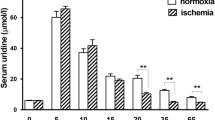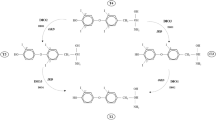Abstract
3-iodothyronamine (T1AM) is an endogenous compound which shares structural and functional features with biogenic amines and is able to interact with a specific class of receptors, designed as trace amine associated receptors. T1AM has significant physiological effects in mammals and produces a reversible, dose-dependent negative inotropic and chronotropic effect in heart. The aim of the present study was to investigate if T1AM is able to reduce irreversible tissue injury in isolated rat hearts subjected to ischemia and reperfusion, as evaluated by triphenyltetrazolium chloride staining. We observed that T1AM reduced infarct size at concentrations (125 nM to 12.5 μM) which did not produce any significant hemodynamic action. The dose–response curve was bell-shaped and peaked at 1.25 μM. T1AM-induced cardioprotection was completely reversed by the administration of chelerythrine and glibenclamide, suggesting a protein kinase C and K +ATP -dependent pathway, while it was not additive to the protection induced by cyclosporine A, suggesting modulation of mitochondrial permeability transition. At cardioprotective concentration, T1AM reduced the time needed for cardiac attest during ischemia, but it did not affect sarcoplasmatic reticulum Ca2+ handling, as demonstrated by unaltered ryanodine receptor binding properties. In conclusion, in isolated rat heart T1AM produces a cardioprotective effect which is mediated by a protein kinase C and K +ATP -dependent pathway and is probably linked to modulation of mitochondrial permeability transition and/or ischemic arrest time.






Similar content being viewed by others
References
Scanlan TS, Suchland KL, Hart ME, Chiellini G, Huang Y, Kruzich PJ, et al. 3-Iodothyronamine is an endogenous and rapid-acting derivative of thyroid hormone. Nat Med. 2004;10:638–42.
Saba A, Chiellini G, Frascarelli S, Marchini M, Ghelardoni S, Raffaelli A, et al. Tissue distribuition and cardiac metabolism of 3-iodothyronamine. Endocrinology. 2010;151:5063–73.
Piehl S, Hoefig C, Scanlan TS, Köhrle J. Thyronamines—past, present, and future. Endocrine Rev. 2011;32:64–80.
Zucchi R, Chiellini G, Scanlan TS, Grandy DK. Trace amine-associated receptors and their ligands. Br J Pharmacol. 2006;149:967–78.
Frascarelli S, Ghelardoni S, Chiellini G, Vargiu R, Ronca-Testoni S, Scanlan TS, et al. Cardiac effects of trace amines: pharmacological characterization of trace amine-associated receptors. Eur J Pharmacol. 2008;589:231–6.
Chiellini G, Frascarelli S, Ghelardoni S, Carnicelli V, Tobias SC, DeBarber A, et al. Cardiac effects of 3-iodothyronamine: a new aminergic system modulating cardiac function. FASEB J. 2007;21:1597–608.
Ghelardoni S, Suffredini S, Frascarelli S, Brogioni S, Chiellini G, Ronca-Testoni S, et al. Modulation of cardiac ionic homeostasis by 3-iodothyronamine. J Cell Mol Med. 2009;13:3082–90.
Zucchi R, Ronca F, Ronca-Testoni S. Modulation of sarcoplasmic reticulum function: a new strategy in cardioprotection? Pharmacol Ther. 2001;89:47–65.
Zucchi R, Ghelardoni S, Evangelista S. Biochemical basis of ischemic heart injury and of cardioprotective interventions. Curr Med Chem. 2007;14:1619–37.
Doyle KP, Suchland KL, Ciesielski TM, Lessov NS, Grandy DK, Scanlan TS, et al. Novel thyroxine derivatives, thyronamine and 3-iodothyronamine, induce transient hypothermia and marked neuroprotection against stroke injury. Stroke. 2007;38:2569–76.
Hart ME, Suchland KL, Miyakawa M, Bunzow JR, Grandy DK, Scanlan TS. Trace amine-associated receptor agonists: synthesis and evaluation of thyronamines and related analogues. J Med Chem. 2006;49:1101–12.
Vivaldi MT, Kloner RA, Schoen FJ. Triphenyltetrazolium staining of irreversible ischemic injury following coronary artery occlusion in rats. Am J Pathol. 1985;121:522–30.
Zucchi R, Ronca-Testoni S, Yu G, Galbani P, Ronca G, Mariani M. Postischemic changes in cardiac sarcoplasmic reticulum Ca2+ channels A possible mechanism of ischemic preconditioning. Circ Res. 1995;76:1049–56.
Zucchi R, Ronca-Testoni S, Yu G, Galbani P, Ronca G, Mariani M. Effect of ischemia and reperfusion on cardiac ryanodine receptors—sarcoplasmic reticulum Ca2+ channels. Circ Res. 1994;74:271–80.
Ping P, Song C, Zhang J, Guo Y, Cao X, Li RC, et al. Formation of protein kinase C(epsilon)-Lck signaling modules confers cardioprotection. J Clin Invest. 2002;109:499–507.
Pravdic D, Sedlic F, Mio Y, Vladic N, Bienengraeber M, Bosnjak ZJ. Anesthetic-induced preconditioning delays opening of mitochondrial permeability transition pore via protein Kinase C-epsilon-mediated pathway. Anesthesiology. 2009;111:267–74.
Gross GJ. The role of mitochondrial KATP channels in cardioprotection. Basic Res Cardiol. 2000;95:280–4.
Jovanovic A, Jovanovic S. SURA2 targeting for cardioprotection? Curr Opin Pharmacol. 2009;9:189–93.
O'Rourke B. Myocardial KATP channels in preconditioning. Circ Res. 2000;87:845–55.
Das M, Parker JA, Halestrap AP. Matrix volume measurement challenge the existence of diazoxide/glibencamide-sensitive KATP channels in rat mitochondria. J Physiol. 2003;547:893–902.
Garlid KD, Costa AD, Quinlan CL, Pierre SV, Dos Santos P. Cardioprotective signaling to mitochondria. J Mol Cell Cardiol. 2009;46:858–66.
Jakobsen Ø, Muller S, Aarsaether E, Steensrud T, Sørlie DG. Adenosine instead of supranormal potassium in cardioplegic solution improves, cardioprotection. Eur J Cardiothorac Surg. 2007;32:493–500.
Author information
Authors and Affiliations
Corresponding author
Rights and permissions
About this article
Cite this article
Frascarelli, S., Ghelardoni, S., Chiellini, G. et al. Cardioprotective Effect of 3-Iodothyronamine in Perfused Rat Heart Subjected to Ischemia and Reperfusion. Cardiovasc Drugs Ther 25, 307–313 (2011). https://doi.org/10.1007/s10557-011-6320-x
Published:
Issue Date:
DOI: https://doi.org/10.1007/s10557-011-6320-x




